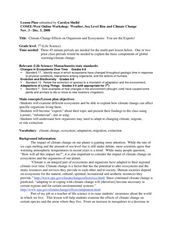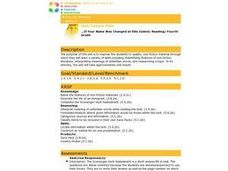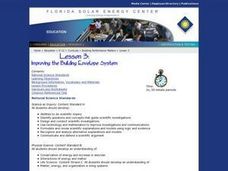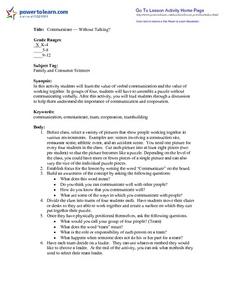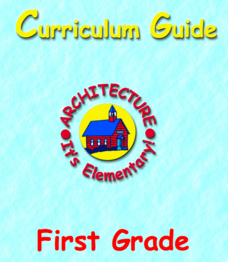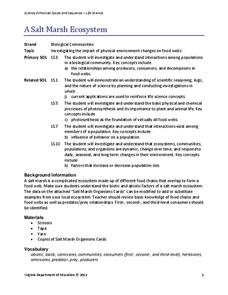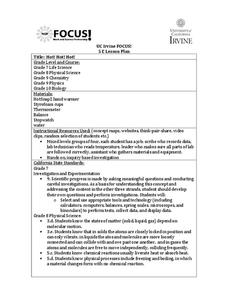Curated OER
Climate Change Effects on Organisms and Ecosystems: You are the Experts!
Seventh graders research about the effect of climate on different ecosystems. In this life science lesson, 7th graders present their research by creating a poster, infomercial, skit or song. They discuss how organisms adapt to climate...
Curated OER
...If Your Name Was Changed At Ellis Island
Fourth graders investigate the concept of and reasons for immigration. They report on an immigrant group that moved to Illinois since 1700.
Curated OER
Improving the Building Envelope System
Students explain the different heat transfer mechanisms and how they influence the building envelope. They develop ways in which the building envelope can be improved and test hypotheses about building envelope designs.
Curated OER
Teenage Boys: Perspectives on the Adolescent Male's Development in an Urban Setting
Students examine the effects of an urban setting on the development of male adolescence. After watching a film, they identify the problems in the relationship of the characters. They discuss the impact of becoming a teenage father and...
Curated OER
Communicate - Without Talking?
Students discuss and define communication and identify different ways of communicating with people. Students then practice team building and non-verbal communication skills as they work silently in small teams to put puzzles together.
Curated OER
String Telephones and Musical Straws
Fourth graders investigate pitches of sound. In this physical science lesson, 4th graders participate in two activities that help them explore pitch--one activity has them working with string telephones and the amount of tension...
Curated OER
A View Of Home From The Front Door and From Space
Students discover how distance can change how our view of an object. Students build a representative model of where their home is located from different distances. They create three drawn models of their home from various elevations as...
Utah Education Network (UEN)
Balanced Diet
Second graders investigate the concept of a balanced diet and how the food pyramid is organized. They conduct research using the links included in the instructional activity. They differentiate the parts of the pyramid while looking at...
Curated OER
Air Pressure
Students perform experiments that demonstrate the characteristics of air pressure. For this physics lesson, students participate and observe experiments using simple household items. The results of these experiments are used to help the...
Curated OER
Creating Comic Strips
Students recognize the elements needed to create a comic strip. In this comic strip instructional activity, student understand that comic strips need words and pictures. Students find differences and similarities in comic strips....
Curated OER
Earliest Americans
Students study the Earliest Americans. In this interactive lesson on the Native Americans, students study different tribes over the course of seven lessons. Students culminate their studies with a presentation and assessment.
Curated OER
Water Wonders
Students explore hydrology concepts. In this environment and biology lesson, students identify and describe macroinvertebrates using a variety of pictures and resources. Students observe and write about a classroom aquarium in which...
Curated OER
Constructing a Periodic Table of Elements
Students create a periodic table of elements. In this chemistry lesson, students work together to build all of the different elements into a complete mini periodic table. They identify similarity and difference of the elements.
Curated OER
Cosmetic Products Evaluation
Students evaluate different cosmetic products. In this chemistry lesson, students determine the physical and chemical components of their samples. They perform various test such as pH, viscosity, conductivity and formulate a conclusion...
Curated OER
Learning About Ratios: A Sandwich Study
Students gain a concrete introduction to the concept of ratios. They demonstrate the ability to create ratios using peanut butter and jelly. They, in groups, construct 6 different sandwiches using different amounts of each food.
Curated OER
Burn, Baby Burn (Or Not)
Physics learners apply the concepts of fluid pressure input and output to firefighting. Divide your class into small groups and give them each a few cards that list nozzle type, hose length, hose size, and structure dimensions, They are...
Curated OER
Things That Glow: From Fireflies to Quantum Dots
Third graders observe light energy. In this heat and energy lesson, 3rd graders will study the concept of light as a form of energy. Students will examine the different forms of light and the type of energy it produces.
Curated OER
Force and Motion - Part 2
Students test different objects such as dominoes, marshmallows, slides, and more to test their force, motion, gravity, friction, and the concept of matter. For this force and motion lesson plan, students understand that the force an...
Michigan Sea Grant
Fish Habitat and Humans
Strict habitat requirements are needed for the survival of fish populations and fish variety in the Great Lakes. Young scientists become experts in the basic needs of fish and understand how survival necessities can vary with different...
Curated OER
Building an Electric Motor
Students study different motors and how they convert electrical energy to mechanical energy. For this motor lesson students make a model of an electric motor and examine how it can be used to do work.
Curated OER
How High Can You Fly?
Students learn the four concepts of flight; drag, lift, thrust, and weight. In this scientific inquiry lesson plan, students participate in a flight activity where they jump as high as they can to stamp a large sheet of paper and measure...
American Institute of Architects
Architecture: It's Elementary!—First Grade
Build an interest and appreciation for architecture in your young learners with this fun 10-lesson art unit. Engaging children in using their five senses, the class first observes the environment around them, paying...
Virginia Department of Education
A Salt Marsh Ecosystem
What a web we weave. Pupils use yarn as the primary resource to create a web depicting the intricacies of a salt marsh ecosystem. They participate in a question and answer session, which leads to an in-depth facilitated discussion...
University of California
Hot! Hot! Hot!
Calories are not tiny creatures that sew your clothes tighter every night, but what are they? A science lesson, presented at multiple levels, has learners experiment with heat, heat transfer, and graph the function over time....
